INTRODUCTION
Dysentery is a more serious form of diarrhea, where the stools are tinged with blood and mucus. The diarrhea can be quite severe, characterized by colicky pains and frequent urging. Stools can be passed as often as fifteen to thirty times per day. Infection of the large intestine causing abdominal cramps and painful diarrhoea with blood.
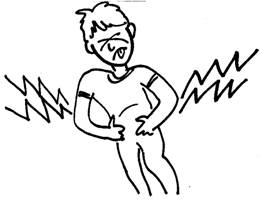
YOGA AND DYSENTRY
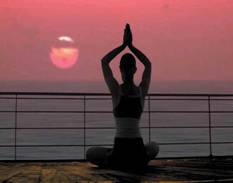
YOGA POSES FOR DYSENTRY
Raised Leg Pose
It balances navel position and stops loose motions. It strengthens the intestines and keeps them healthy. It overcomes constipation and other stomach diseases. It increases digestive fire and relieves stomachache; it is also beneficial in case of respiratory diseases.
Bow Pose
It overcomes imbalance of navel and is beneficial in case of loose motions also. It cures stomach diseases, makes the spine healthy, flexible and strengthens the kidneys.
Wheel Pose
This pose prevents imbalance of navel and controls dysentery. It makes the spine flexible, improves the health of stomach and intestines, and overcomes the diseases of the uterus.
Fish Pose
Practice of fish pose is also beneficial in this case. It overcomes problems related to thyroid and Para-thyroid. It improves the health of stomach and makes the intestines active.
Mountain Pose
Tadasana, with 'tada' meaning 'mountain', is regarded as one of the most beneficial postures in yoga. Though it seems to be quite simple, a person has to undergo lots of practice to attain the perfect tadasana posture. The asana is believed to provide not only physical, but mental benefits as well. It helps a person improve his posture and also promotes confidence as well as happiness.
YOGA ASANAS FOR DYSENTRY
SHAVASANA
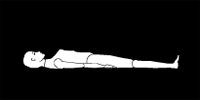
Shavasana is relaxation of body and mind in the position of lying on the back. This asana helps in relaxing mind and body and helps in restoring energy. It is a relaxing posture intended to rejuvenate one's body, mind and spirit. While shavasana is a good way to reduce stress and tension it is not recommended for meditation as it has a tendency to induce sleepiness..
Steps
• Lie on the back.
• Keep your spine, navel & pelvic in one line.
• Keep feet apart.
• Keep arms on the each side of body, palms facing to sky.
• Keep neck right or left side.
• Close your eyes & slowly try to concentrate each part of the body & try to relax that part.
SARVANGASAN
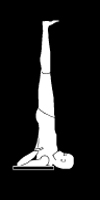
This asana is very good for the thyroid gland. This asana improves the reproductive organs in both men and women. It also helps in relieving bronchitis, dyspepsia, and varicose veins and increases digestive capacity. It stimulates the thyroid and para-thyroid glands and influences the brain, heart and lungs, and improves blood circulation. However, those suffering from high blood pressure should not practice this posture. The sarvanga-asana should not be performed by woman who are menstruating, as is the case with all inverted postures (where the legs are raise over the head.
Steps
• Lie on your back with legs and arms straight, feet together and palms on the floor beside your body. While exhaling, raise your legs slowly upto 90 and then the whole body and the rest your weight on the arms so that the chin touches the jugular notch.
• Bring the arms and hands to support your body at the hip region (fingers at the back and thumb in front of the body). The entire weight of your body rests on the head, neck and shoulders while the arms are used for balancing.
• Keep the trunk, legs and hips in a straight line and as vertical as possible Focus your eyes on your toes, with your chin pressed against the chest. Retain the posture for one for three minutes.
• While exhaling, return to the lying position by bringing the leg backward and releasing the hands and the palms.
BADDHAPADMASANA
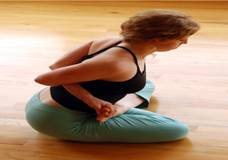
The posture gets its basic name (Padmasana) because the person performing it resembles a Lotus. The name Baddha signifies that the body is restrained by the locking together of the crossed hands (at the back) and the crossed legs (in the front).
Steps
• Sit on the floor, back straight and legs extended straight in front of you. Exhale and bend your right knee, bringing your right foot up and across the top of your upper left thigh. Continue to exhale and bend your left knee, placing your left foot on top of your right upper thigh. You are now in the full lotus posture of Padmasana.
• Inhale and sweep your left arm behind your back, reaching your hand to your right hip, grabbing your left big toe.
• Continue to inhale and sweep your right arm behind your back, taking your hand toward your left side to take hold of your right big toe.
• Breathe steadily for ten to twenty breaths while pushing your weight down through your pelvis, into the floor. Consciously feel all the tension in your body drain into the floor with each exhalation. After your ten to twenty breaths, you should inhale while releasing your arms and feet. You have just completed the Baddha Padmasana.
KUKKUTASANA
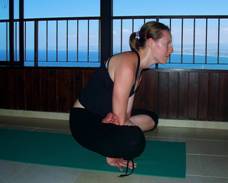
This asana is also known as the Cock pose.Kukkuta is a Sanskrit word which means a cock.This asana resembles that of a cock and hence the name is Kukkutasana. It is also an exciting variation of padmasana (lotus).
Steps
• Sit on the ground with your head and spine erect. Now extend your legs forwards such that your knees and heels are placed together. With the help of your hands, place your right foot on the left thigh and then similarly the left foot on the right thigh.
• Move your arms through the gaps between your calves and your thighs close to the knees so as to place your palms firmly on the ground.
• Breathe out, and smoothly raise your body above ground level so that your entire body weight is balanced on your palms and your legs are nearly at the elbow level. And then continue to breathing normally.
• Remain in this final posture for 5-10 seconds. And you can also increase the duration of being in this posture with time.
• At very early stages of performing this asana you might feel trembling sensations in your hands. But when practiced regularly on a daily basis this weakness is easilyovercome.
SHIRSHASANA
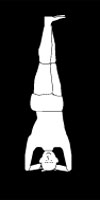
This asana is helpful in cases of dyspepsia and constipation. It improves the functions of the reproductive glands and heart muscles and is of great advantage in checking wet dreams.
Steps
• Sit in a kneeling position with the buttocks resting on the heels of the feet.
• Lean forward and place the forearms on the floor in front while keeping the elbows about shoulder distance apart. Interlock the fingers of both hands.
• Place the top of the head flat on the floor with the back of the head pressed against the inside of the interlocked fingers.
• Placing the tips of the toes firmly on the floor while lifting the heels, raise the knees off the floor.
• Hold for the duration of the held inhaled breath. When you can't hold the breath comfortable any longer, slowly exhale and return the back to the floor, slide the legs out straight returning to the shava-asana.
ASTROLOGY
Yoga is a Sanskrit term which means 'to unite'. What is being referred as the 'Yoga' in English, is more commonly known as 'Asana' in Sanskrit, which means different physical postures and poses. It is seen that people of a particular sun sign find it beneficial when they practice certain yoga asanas. According to astrological reports for yoga asanas the above mentioned asanas are said to be effective for those who come under the following zodiac sign.
• CANCER
• VIRGO
• LIBRA